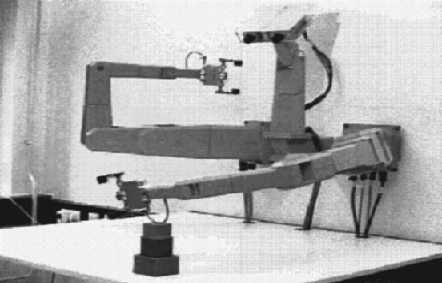

The Theory Laboratory at GMD is made up of members from the Adaptive Systems research group. The group was formed unofficially in 1987, and was inaugurated officially in 1991. The groupıs research is interdisciplinary, and its goal is to investigate how natural and artificial systems can adapt in real world environments. The research will ultimately be applied to autonomous robotics and to the synthesis of programs from examples. The group makes use of ideas not only from computer science but also from natural science, especially theoretical biology, ethnology, and brain research.
The real world is open and ambiguous. The problem of its openness has been neglected in science for a long time, especially in artificial intelligence. Any knowledge of the real world that is formulated as a hypothesis must be treated as preliminary, subject to rejection if new data contradicts the hypothesis. In addition, adaptive systems must occasionally fail and then learn from these failures. These requirements can be highly problematic for a technical system and are the primary motivation for our fundamental design principle: reflection. We believe that reflection is a necessary condition for an adaptive system to operate reasonably in an open world. A reflective system tries to estimate what it knows and - even more important - what it does not know. This is done incrementally through self assessment. Before taking on a new task, the system can inform a human operator as to its assessment of the task.
A necessary condition for an intelligent system is that it can adapt at different time scales and using a variety of methods. We have investigated adaptation through evolution, reflective learning, and physical interaction. We decided to first investigate the different principles in isolation. Later we will investigate how to combine them in a synergistic manner.
Adaptation by simulating evolution
There was and still is much hype concerning the efficiency of Darwinian "natural selection." In fact, Neo-Darwinism seems to be getting increasingly popular. From philosophy to brain research (the brain as a Darwinian machine), more and more issues are now being explained as simply natural selection. We have investigated the efficiency of Darwinian evolution in detail, and have developed two different evolutionary algorithms, the parallel genetic algorithm (PGA), which models self-organized "natural selection," and the breeder genetic algorithm (BGA), which models selection when controlled by human breeders. Our research in this area has been supported by RWCP, and it has succeeded in showing that the Darwinian/Mendelian model of evolution is a minimal model: it is nowhere near what is required to explain or even to predict the evolutionary processes. Our theoretical results have been used in a number of difficult real-world optimization problems. Most notable are large vehicle-routing problems and the channel-assignment problem of mobile-radio applications.
Adaptation by reflective learning
A reflective learning system must take into account what it does not (yet) know. Such a system tries to determine its lack of knowledge through introspection. It can increase its knowledge later by actively raising queries or performing experiments. Our main interest focuses on reflective exploration techniques, but we have used reflection for model selection and prediction as well. In order to estimate the confidence of a prediction, bootstrap methods and Bayes statistics have been used. Our techniques have been applied to real world problems in credit scoring.
Adaptation by physical interaction
Our robotics research in part uses theoretical results obtained from the above described areas. The goal is to control the hand-eye robot JANUS (see photo) with two manipulators and a vision system. The system's architecture is built on communities of simple adaptive agents using specific heuristics. They cooperate and compete; the research is mainly concerned with integrating the various agents' contributions in order to produce harmonious overall system behavior. More up-to-date information is available on our Web site at:
Within the SIFOGA project we have investigated the genetic algorithm in detail. By transferring classical concepts from population genetics and quantitative genetics to genetic algorithms we have been able to give an exact proof that one of the most controversial conjectures in population genetics, Fisherıs fundamental theorem of natural selection, is wrong. Fisher claimed that the average fitness of a genetic population always increases in evolution. Our proof shows that this claim is not correct, but it also shows that a genetic algorithm is not a global optimization method, in contrast to the belief of many researchers. The standard genetic recombination methods mainly exploit the additive genetic variance VA; nonlinear interactions between variables are not taken into account.
We will extend the traditional genetic algorithms by using sophisticated statistical methods for recombining promising genes instead of the simple Mendelian recombination. In a next step, we will use our exploration concept for optimization methods. We will formulate specific utility functions which encourage the generation of new examples in points with probably high fitness values. A related approach is the estimation of a distribution concentrated in high fitness values to generate points in these areas. The methods will be exploited by applying them to commercial or "Grand Challenge" applications.
The hand-eye robot JANUS will be given more complex manipulation tasks. These experiments will show whether the JANUS architecture already has the complexity necessary to incrementally and autonomously solve these tasks. In more basic research the group will start to combine the different adaptation methods. The most interesting question concerns the relation between genetic information transformed by evolutionary processes and neuron information.
